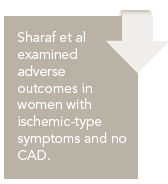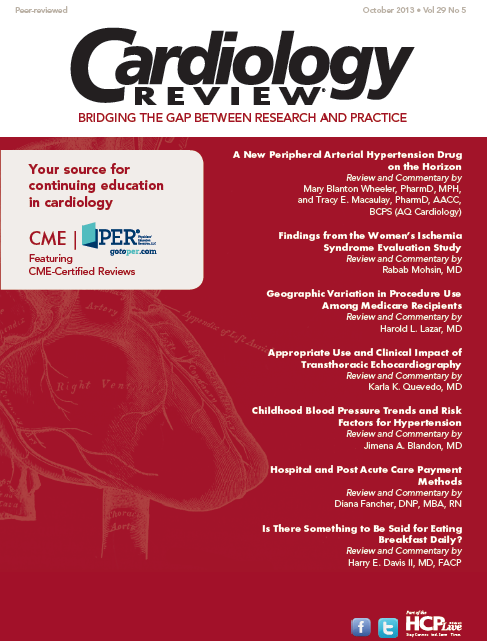Publication
Article
Cardiology Review® Online
Findings from the Women's Ischemia Syndrome Evaluation Study
Author(s):
Rabab Mohsin, MD, reviews adverse outcomes among women from the Women's Ischemia Syndrome Evaluation (WISE) study.

Rabab Mohsin, MD
Review

Sharaf B, Wood T, Shaw L, et al. Adverse outcomes among women with signs and symptoms of ischemia and no obstructive coronary artery disease: findings from the National Heart, Lung, and Blood Institute-sponsored Women’s Ischemia Syndrome Evaluation (WISE) angiographic core laboratory. Am Heart J. 2013;166:134-141.
Specific clinical recommendations for the prevention of cardiovascular disease in women were first published by the American Heart Association (AHA) in 1999. Since the early 1990s, women have been categorized as a “special group” entity in major cardiovascular journals. Gender-specific studies have become more popular in the past 2 decades mostly due to the increased interest in the differing management and presentation of heart disease in women versus men.
Public awareness of heart disease in women has grown as a result of the publicity some studies have received.1 Gender variations in prevention, management, diagnosis, and continued care have all been areas of interest. In 2010, an AHA national survey was completed over a 12-year period; in the study, only 53% of women said they would call 911 if they thought they were having a heart attack.1 Women with atypical cardiac symptoms have approximately twice the delay for hospitalization, are less likely to receive therapy from physicians, and have higher mortality rates than men. When comparing the respective risk profiles of men and women, women are more likely to be considered as low risk.2
The Women’s Ischemia Syndrome Evaluation (WISE) is a 4-center protocol initially designed in 1999 by Merz et al as a 3-objective study. The protocol was designed to evaluate ischemic symptoms and their pathophysiologic mechanisms, optimize diagnostic testing, and evaluate the influence of reproductive hormones, including menopause, and the correlations with ischemic heart disease.3
Various studies have explored the risk factors, diagnostic mechanisms, and the prognostic factors for women presenting with chest pain. The marked differences in findings on angiography and coronary anatomy between men and women presenting with chest pain are significant. A 2009 study published in the American Heart Journal showed that 1,494 patients with non-ST elevation myocardial infarction (NSTEMI) with absence of obstructive coronary artery disease (CAD) were more often women.4
The WISE study was completed in multiple phases. Lead author Barry Sharaf, MD, is an original member of the WISE core angiographic laboratory group at Rhode Island Hospital. The objective of WISE is to look at the long-term adverse prognostic factors associated with no CAD and non-obstructive CAD. The multiple phases of the WISE protocol allowed the incorporation of multiple hypotheses for advancing and improving upon diagnostic tools for improvement in women’s health.
Study Details
Sharaf et al examined adverse outcomes in women who have ischemic-type symptoms and no CAD. The source of their investigation was the WISE registry, a study cohort consisting of 917 women enrolled in a program sponsored by the National Heart, Lung, and Blood Institute. An exclusion criterion for screening was any contraindication to stress testing. The WISE coronary angiography lab was blinded to patient demographics. All coronary lesions were measured quantitatively, and a stenosis severity score was applied to all coronary lesions. The range of disease was 5 (no CAD), to more than 50 (3-vessel disease and diffuse obstructive lesions). All coronary lesions were categorized into 3 divisions:
- No CAD: normal-appearing coronary arteries, no diameter stenosis ≥20%
- Non-obstructive CAD: at least 1 diameter stenosis ≥ 20 but ≤50%, and
- Obstructive (single, double, or triple vessel) CAD, at least 1 diameter stenosis >50%.
Of 917 women participating in the study, 37% had no CAD, 25% had non-obstructive CAD, and 38% had obstructive CAD. The authors were able to populate multiple end points in the study. The notable conclusions were that the cumulative 10-year adverse events—cardiovascular mortality or nonfatal myocardial infarction—increased or doubled in proportion from the no-CAD group to the non-obstructive CAD to the obstructive CAD. The authors saw a linear increase in this relationship when they compared the adverse events to increasing stenosis severity score. The degree of medical therapy and repeat coronary angiograms also increased over the follow-up period with respect to initial stenosis severity score.
The authors were able to make significant conclusions based on the study. Women presenting with angina with non-obstructive lesions were 62% of the total population in the study. Women with higher WISE angiographic scores more often received optimum medical treatment, although, as expected, they had a greater number of adverse events. However, the authors note that the non-obstructive population did have cardiovascular death and increased risks for events such as nonfatal stroke. To a large degree, treatment of atherosclerosis-related disease was not implemented for women with non-obstructive CAD; however, this area needs further prognostic studies. Mechanisms for ischemic heart disease and angina-type symptoms were difficult to pinpoint and further research is needed on this topic. The authors note that among the women with no CAD, 5% had a history of MI, and 43% had a positive noninvasive test for ischemia.
CommentaryGender Matters in Heart Disease
Much has been theorized and studied in women’s health, specifically in heart disease. Although much of clinical medicine has no gender-specific treatments, practitioners do make an effort to look at male and female gender when committing to a management program in heart disease. The authors noted the historical lack of quantitative measures in obtaining data on non-obstructive CAD and correlations of adverse outcomes. The 917 patients studied had stable cardiac symptoms, and not acute ischemic complaints, since they would have been excluded if they could not undergo stress testing. The next important factor to appreciate in this study is that the quantitative analysis completed for every lesion was a computer score and not a visual estimation. Stable cardiac symptoms and computer scoring were an advantage in the study because they led to a more objective analysis. Patients with no CAD and those with obstructive CAD were 37% and 38% of the study subjects, respectively. However, non-obstructive CAD represents about 25% of the population. Therefore, when the authors noted that, overall, the cardiovascular death or nonfatal MI rates doubled from no CAD to non-obstructive CAD, it implies that diffuse atherosclerotic disease plays a major role in adverse outcomes in this population. Gulati et al compared WISE women with a cohort of asymptomatic women who had a lower prevalence of obesity, family history of CAD, hypertension, and diabetes mellitus (P <0.001).5 Cardiac risk factors are higher in women presenting with ischemic symptoms, which leads to the worse overall prognosis. The authors call for an increased protocol that risk stratifies this population.
It is important to also acknowledge that in patients presenting with chest pain and ischemic symptoms, approximately 60% had no CAD or non-obstructive CAD. The importance of critically reviewing patients presenting with signs and symptoms of CAD becomes not only a quality improvement measure but also one of cost-effectiveness. Sharaf et al’s findings support the ACC’s 2003 report that approximately 7 million cardiac catheterizations were performed—part of the average 5-year cumulative cardiac cost of $32,239 per female patient—with no CAD or nonobstructive CAD, reported in up to 60% of women.6
This study was not able to determine the mechanisms involved in the finding that the prognosis afterward is not as benign as initially thought for non-obstructive disease. A 2005 meta-analysis review article in JAMA postulated that atherosclerotic-related endothelial function may play a role in the malignant prognosis of this patient population.7 Plaque disruption, ulceration, vasospasm, and distal embolization are also thought to be part of the mechanism in non-obstructive CAD, documented using cardiac MRI and intravascular ultrasound in a 2011 prospective study by Reynolds et al.8 Cardiac MRI and intravascular ultrasound are 2 modalities also used in defining the ischemic burden or the anatomy of the lumen of coronary arteries. Johnson et al were able to show the economic burden that these tests, repeat hospitalizations for ischemia, and continued mental and physical exhaustion have created for women. This new and difficult paradigm makes practitioners resist treatment. They looked into a new tool, nuclear magnetic resonance spectroscopy (MRS), and suggested that stress-induced markers such as ATP could be an ischemic-equivalent marker. MRS provides a new strategy in evaluating women with myocardial ischemia.9
This study was not able to determine the mechanisms involved in the finding that the prognosis afterward is not as benign as initially thought for non-obstructive disease. A 2005 meta-analysis review article in JAMA postulated that atherosclerotic-related endothelial function may play a role in the malignant prognosis of this patient population.7 Plaque disruption, ulceration, vasospasm, and distal embolization are also thought to be part of the mechanism in non-obstructive CAD, documented using cardiac MRI and intravascular ultrasound in a 2011 prospective study by Reynolds et al.8 Cardiac MRI and intravascular ultrasound are 2 modalities also used in defining the ischemic burden or the anatomy of the lumen of coronary arteries. Johnson et al were able to show the economic burden that these tests, repeat hospitalizations for ischemia, and continued mental and physical exhaustion have created for women. This new and difficult paradigm makes practitioners resist treatment. They looked into a new tool, nuclear magnetic resonance spectroscopy (MRS), and suggested that stress-induced markers such as ATP could be an ischemic-equivalent marker. MRS provides a new strategy in evaluating women with myocardial ischemia.9
The study showed that treatment of CAD or repeat coronary angiography increased with increasing severity of stenosis. A future study may reveal whether there is a gender difference that can be seen in prescribing aggressive atherosclerotic risk-reduction medications.
One of the striking limitations of the Sharaf study is that the 10-year cumulative data for death and MI was underestimated because the data were mostly gathered from the phase 1 follow-up period, which had a median duration of 6 years. This may change the trend and the patterns noted in the study since the non-obstructive disease was just a quarter of the patient population and yet still carried such a high mortality. In addition, the authors were limited in the scope of the follow-up in this population.
Although this article made great strides by quantifying stenosis severity and looking at adverse outcomes in women with no CAD or non-obstructive CAD, there need to be larger data groups comparing gender management and diagnostics. Also, the hormonal and psychiatric implications of disease were not discussed in this study, though they play a major role in the diagnosis and presentations of ischemic symptoms for women in both the inpatient and outpatient setting.
References
1. Mosca L, Benjamin E, Berra K, et al. Effectiveness-based guidelines for the prevention of cardiovascular disease in women--2011 update: a guideline from the American Heart Association. J Am Coll Cardiol. 2011;57:1404-1423.
2. Bugiardini R. Women, “non-specific” chest pain, and normal or near-normal coronary angiograms are not synonymous with favorable outcome. Eur Heart J. 2006;27:1387—1389.
3. Merz C, Bairey N, Kelsey S, et al. The Women’s Ischemia Syndrome Evaluation (WISE) study: protocol design, methodology and feasibility report. J Am Coll Cardiol. 1999;33:1453-1461.
4. Gehrie ER, Reynolds H, Chen A, et al. Characterization and outcomes of women and men with non—ST-segment elevation myocardial infarction and nonobstructive coronary artery disease: Results from the Can Rapid Risk Stratification of Unstable Angina Patients Suppress Adverse Outcomes with Early Implementation of the ACC/AHA Guidelines (CRUSADE) Quality Improvement Initiative. Am Heart J. 2009;158:688-694.
5. Gulati M, Cooper-DeHoff RM, McClure C, Johnson BD, et al. Adverse cardiovascular outcomes in women with non-obstructive coronary artery disease: a report from the Women’s Ischemia Syndrome Evaluation Study and the St James Women Take Heart Project. Arch Intern Med. 2009;169:843-850.
6. Shaw L, Merz C, Pepine CJ, Reis SE, et al. The economic burden of angina in women with suspected ischemic heart disease: results from the National Institutes of Health-National Heart, Lung, and Blood Institute-Sponsored Women’s Ischemia Syndrome Evaluation. Circulation, 2006;114:894-904.
7. Bugiardini R, Merz C. Angina with “normal” coronary arteries: a changing philosophy. JAMA. 2005;293:477-484.
8. Reynolds HR, Srichai MB, Iqbal SN, et al. Mechanisms of myocardial infarction in women without angiographically obstructive coronary artery disease. Circulation. 2001;124:1414-1425.
9. Johnson BD, Shaw LJ, Buchthal SD, et al. Prognosis in women with myocardial ischemia in the absence of obstructive coronary disease: results from the National Institutes of Health--National Heart, Lung, and Blood Institute-Sponsored Women’s Ischemia Syndrome Evaluation (WISE). Circulation. 2004;109:2993-2999.
About the Author
abab
ohsin
RM, MD, is a Cardiology Fellow at Texas Tech Medical Center in El Paso, Texas. She is board certified in Internal Medicine. Dr. Mohsin received her MD from Ross University School of Medicine, Dominica, West Indies, and completed a residency in internal medicine at University of Kentucky in Lexington, where she participated in cardiac research protocols. She has published multiple abstracts on atrial fibrillation, obesity, and anticoagulation. Currently, she is working on a number of projects in the Hispanic population, including acute coronary syndromes and risk for GI bleeds.






